low.safety.standards
Harmless

Posts: 28
Registered: 17-7-2018
Member Is Offline
|
|
Why is my dinitrogen tetroxide green?
Hello people,
I liquefied NO2 with a cold trap and got a deep green color in my N2O4 (instead of deep brown/red). It's the second time I generate it from different
sources with different glassware and it turns green. Any ideas? 
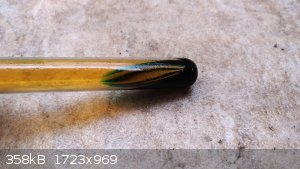
|
|
|
WGTR
National Hazard
   
Posts: 971
Registered: 29-9-2013
Location: Online
Member Is Offline
Mood: Outline
|
|
Because it has some N2O3 dissolved in it. Pure N2O3 would be dark blue. How did you generate it?
|
|
|
low.safety.standards
Harmless

Posts: 28
Registered: 17-7-2018
Member Is Offline
|
|
Quote: Originally posted by WGTR  | | Because it has some N2O3 dissolved in it. Pure N2O3 would be dark blue. How did you generate it?
|
Ohhh I see... This time it was Copper + RFNA, and Sulfure + RFNA last time.
|
|
|
WGTR
National Hazard
   
Posts: 971
Registered: 29-9-2013
Location: Online
Member Is Offline
Mood: Outline
|
|
In practice, some of the produced NO2 can react with the water that is formed to produce more nitric and nitrous acids. Invariably some NO
is produced, and this combines with NO2 to form N2O3 on condensation. When I react copper with some nitric acid in a
loosely stoppered test tube, at first brown gas is produced, then over time the gas color turns clear. Once the stopper is removed briefly, the gas
turns brown again as oxygen enters the tube.
If you cool down your condensed product a bit below 0°C, then you can very slowly and carefully let drops of water into the test tube. Don't let
them drip into the liquid, but only run down the insides of the test tube, so that no mixing occurs. The water will react with the
N2O4, creating nitric acid around 68% concentration, with possibly some dissolved N2O4. This layer will
float on top. On the bottom, intensely blue N2O3 will form, like in this post: https://www.sciencemadness.org/whisper/viewthread.php?tid=84...
You could probably take the N2O3 and make nitrite from it, but I've never tried it.
|
|
|
low.safety.standards
Harmless

Posts: 28
Registered: 17-7-2018
Member Is Offline
|
|
Quote: Originally posted by WGTR  |
If you cool down your condensed product a bit below 0°C, then you can very slowly and carefully let drops of water into the test tube.
|
I need it as dry as possible. The purpose is to use as oxidizer for a hypergolic mixture with turpentine. I saw in Purification of Laboratory
Chemicals that I can bubble oxygen at 0° to oxidize the N2O3 to N2O4, I assume I have low water content to be getting this color, right?
|
|
|
WGTR
National Hazard
   
Posts: 971
Registered: 29-9-2013
Location: Online
Member Is Offline
Mood: Outline
|
|
You may have a few percent water, but I don’t know how dry you really need it to be. If you had a lot of water, I think you’d see a second layer
floating on top. If you want it very dry, you could add water to your fuming acid to dilute it, and then react that with your copper. The primary
product would then be nitric oxide, which could be dried by passing it through silica gel. After the drying process, it could then be mixed with
oxygen to allow it to oxidize to nitrogen dioxide, and then condensed. With this idea, keep in mind that catalytic trace amounts of water are
required for the oxidation to occur, so if the reaction is completely anhydrous you’ll end up with nitric oxide only. In practice, I don’t think
you’d end up with conditions that dry to worry about that.
|
|
|
low.safety.standards
Harmless

Posts: 28
Registered: 17-7-2018
Member Is Offline
|
|
Quote: Originally posted by WGTR  | | You may have a few percent water, but I don’t know how dry you really need it to be. If you had a lot of water, I think you’d see a second layer
floating on top. If you want it very dry, you could add water to your fuming acid to dilute it, and then react that with your copper.
|
That's what I did! I tried exactly what you described, the N2O4 was made from 90%+ fuming nitric acid with copper (sulfur previously), the gas was
passed through silica cat liter and nothing came out, silica gel absorbs N02 quite efficiently!
|
|
|
fusso
International Hazard
    
Posts: 1922
Registered: 23-6-2017
Location: 4 ∥ universes ahead of you
Member Is Offline
|
|
Quote: Originally posted by low.safety.standards  | | That's what I did! I tried exactly what you described, the N2O4 was made from 90%+ fuming nitric acid with copper (sulfur previously), the gas was
passed through silica cat liter and nothing came out, silica gel absorbs N02 quite efficiently! |
Why would you use S to make NO2? S may not be oxidized to H2SO4 completely and some SO2 may form, but I'm not sure about this.
Probably decomposing nitrate salts may yield purer NO2/N2O4.
By the way why's this in EM instead of gen chem?
[Edited on 25/09/18 by fusso]
|
|
|
walruslover69
Hazard to Others
  
Posts: 216
Registered: 21-12-2017
Member Is Offline
Mood: No Mood
|
|
Calcium chloride, would probably make a good desiccant.
|
|
|
woelen
Super Administrator
        
Posts: 7976
Registered: 20-8-2005
Location: Netherlands
Member Is Offline
Mood: interested
|
|
No, CaCl2 is a very bad drying agent in this case. I know from experience. It reacts with NO2, the reaction products being mainly ONCl (nitrosyl
chloride) and nitrate ion. You also may get some Cl2.
Making pure liquid NO2/N2O4 is very difficult in a home setting. I tried several times but never succeeded. I want a nice sample for display purposes,
but I always end up with a dark green/blue liquid. Oxidizing it with O2 might be an option, but with the bubbling O2 you lose most of your volatile
liquid as gas. If you have very good cooling, then it may work, but I do not have the equipment for that.
|
|
|
low.safety.standards
Harmless

Posts: 28
Registered: 17-7-2018
Member Is Offline
|
|
Quote: Originally posted by fusso  | | Why would you use S to make NO2? S may not be oxidized to H2SO4 completely and some SO2 may form, but I'm not sure about this. Probably decomposing
nitrate salts may yield purer NO2/N2O4. |
Fuming HNO3 + S releases lots of NO2! much faster than with Cu, and I wanted to try to convert the H2SO3 to H2SO4 later.
I thought people around this section could give me better insights, I'm making "dry as possible" N2O4 for rocket fuel oxidizer.
Quote: Originally posted by woelen  | | Making pure liquid NO2/N2O4 is very difficult in a home setting. I tried several times but never succeeded. I want a nice sample for display purposes,
but I always end up with a dark green/blue liquid. Oxidizing it with O2 might be an option, but with the bubbling O2 you lose most of your volatile
liquid as gas. If you have very good cooling, then it may work, but I do not have the equipment for that. |
I have a 15 amp peltier I could use to make a cold finger for a methanol bath, I'm going to try and assemble something. I also wanted a pure NO2
ampoule to demonstrate the equilibrium between NO2<->N2O4 at different temperatures. Pic shows that near 0º the red gas tint is greatly
reduced, I'll try bubbling in these conditions.
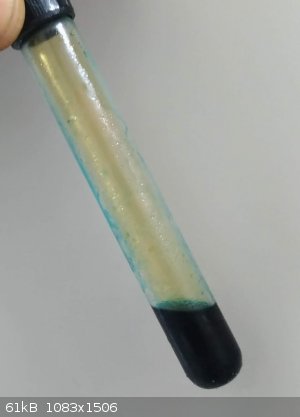
|
|
|
WGTR
National Hazard
   
Posts: 971
Registered: 29-9-2013
Location: Online
Member Is Offline
Mood: Outline
|
|
Quote: Originally posted by low.safety.standards  | | That's what I did! I tried exactly what you described, the N2O4 was made from 90%+ fuming nitric acid with copper (sulfur previously), the gas was
passed through silica cat liter and nothing came out, silica gel absorbs N02 quite efficiently! |
Ahhh, but you forgot to dilute the acid with water first. With dilute nitric acid you primarily get nitric oxide instead of nitrogen dioxide with
concentrated acid. Maybe I can demonstrate it if I can find some time; it shouldn’t take too long.
As an FYI, you can recover the nitrogen dioxide from silica gel by heating it.
|
|
|
low.safety.standards
Harmless

Posts: 28
Registered: 17-7-2018
Member Is Offline
|
|
Quote: Originally posted by WGTR  |
Ahhh, but you forgot to dilute the acid with water first. With dilute nitric acid you primarily get nitric oxide instead of nitrogen dioxide with
concentrated acid. Maybe I can demonstrate it if I can find some time; it shouldn’t take too long.
As an FYI, you can recover the nitrogen dioxide from silica gel by heating it. |
That would explain why I got such a deep green/blue tint, even small droplets are blueish.
Thanks for the tip, I haven't opened the dryer yet to see in what state the silica is in. I know a lot got into it, when I didn't see anything coming
through I generated a lot more NO2, it captured everything.
The Handbook of Preparative Inorganic Chemistry says to generate NO2 from lead nitrate dried in an oven for several days.
P2O5 is used to dry it further but there are several other steps and a complicated apparatus with cold traps and a furnace. It
mentions a path for very pure NO2 with N2O5 but both need phosphorus. Sadly doesn't mention how much you get for each
procedure. Possibly generating it from a dried salt alone may be enough for my purpose. I'll try bubbling O2 and determining the water
content of what I have now first.
[Edited on 25-9-2018 by low.safety.standards]
|
|
|
WGTR
National Hazard
   
Posts: 971
Registered: 29-9-2013
Location: Online
Member Is Offline
Mood: Outline
|
|
If you use clear, non-indicating silica gel, it will turn yellowish-brown as it saturates with NO2. NO by itself will not adsorb onto
silica in any appreciable amount. If oxygen is present, then silica will catalyze the oxidation of NO to NO2, which will then adsorb onto
the silica, provided that the silica is dry, and not already saturated with NO2. NO2-saturated silica should also catalyze the
oxidation of NO, but this is something that I'd like to verify.
[Edited on 9-25-2018 by WGTR]
|
|
|
WGTR
National Hazard
   
Posts: 971
Registered: 29-9-2013
Location: Online
Member Is Offline
Mood: Outline
|
|
Here, I whipped up a quick experiment and took some pictures.
In the picture of the overall setup, this picture was taken after the experiment was completed. I just put everything back together to show how
things were assembled.
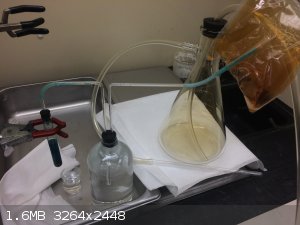
The test tube on the left contained ≈50% nitric acid and copper wire. The gasses coming from the test tube were bubbled through water (large 1L
bottle, almost completely full of water to minimize head space) to remove any residual NO2, and convert part of it to NO, and also to
remove any acid mist. Gasses leaving this bottle were passed through a short train of indicating silica gel. The other end of this tube was pushed
tightly through a sealed Ziploc bag. The Erlenmeyer flask isn't part of the experiment.
Even though I took care to exclude oxygen, the silica gel almost immediately turned dark brown. It's possible that the gel itself contained oxygen.
The bag filled with a gas that was only vaguely yellow, but filled just the same. After filling the bag half-full with gas, the silica gel/plastic
bag assembly was removed, and then a slight excess of dry oxygen (from an oxygen cylinder used for welding) was passed through the silica gel into the
bag. As the oxygen flowed into the bag, the gas immediately turned dark brown. Also, the oxygen served to flush NO2 from the silica gel,
changing its color to a light green color.
In my experience, once NO2 has been adsorbed onto blue indicating silica gel, it will never be blue again, no matter how much heating is
applied. It will always be a light green color, even after the NO2 has been expelled.
After waiting a few minutes, the bag was placed over an open dewar containing liquid nitrogen. One corner of the bag was close to the boiling
nitrogen, but was not submerged into it. It was about 1" away from the surface. A freezing salt mixture would probably work just as well, if the bag
was submerged a bit, and more time was allowed for condensation.
After waiting for the N2O4 to freeze in the corner of the bag, the bag was removed, and allowed to thaw. A straw-colored liquid
collected in the bottom corner (picture is rotated).
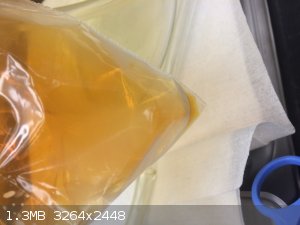
At no time did I observe any blue or green coloration, in the solid or liquid phase. The frozen material was white, and the liquid was a straw color
as seen above.
After returning to the lab 10 minutes later, all of the liquid had evaporated except for a handful of very, very, tiny droplets. I'm not sure what
those are. Perhaps it's from some residual moisture.
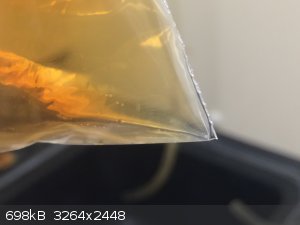
|
|
|
fusso
International Hazard
    
Posts: 1922
Registered: 23-6-2017
Location: 4 ∥ universes ahead of you
Member Is Offline
|
|
Quote: Originally posted by WGTR  | | In my experience, once NO2 has been adsorbed onto blue indicating silica gel, it will never be blue again, no matter how much heating is
applied. It will always be a light green color, even after the NO2 has been expelled. |
Does NO(2)
react with/complex to the metal in H2O indicator?
|
|
|
low.safety.standards
Harmless

Posts: 28
Registered: 17-7-2018
Member Is Offline
|
|
I'll follow that as I lost all my N2O3 overnight, it ate through what was supposed to be a Teflon cap on that test tube It was
stored. Luckly I store high chemicals underwater @home so the gasses were mostly absorbed.
[Edited on 26-9-2018 by low.safety.standards]
|
|
|
DBX Labs
Hazard to Self
 
Posts: 57
Registered: 24-12-2020
Member Is Offline
|
|
A few days back I fed some NO2/NO from a nitrite / H2SO4 decomposition into ampoules cooled down to around -40C. Though in this instance my intention
was to make N2O3 as pure as possible, in future trials I think I’m going to feed some pure O2 into the ampoules containing N2O3 before sealing to
convert it all to NO2/N2O4.
Another idea that came to mind was possibly adding weak H2O2 to the Sulfuric (pure sulfuric doesn’t easily react with pure nitrite so it could be
used instead of water to dilute) and maybe that could slowly decompose producing more NO2. I know there’s other ways of directly producing NO2 but
RFNA plus most metals doesn’t give much NO2 per gram and RFNA plus sulfur gives impurities in the condensed liquid.
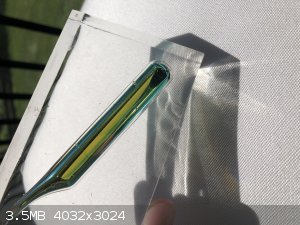
|
|
|
caterpillar
Hazard to Others
  
Posts: 472
Registered: 8-1-2012
Member Is Offline
Mood: No Mood
|
|
RFNA ignites turpentine- I made such an experiment. No need for N2O4.
Women are more perilous sometimes, than any hi explosive.
|
|
|
DBX Labs
Hazard to Self
 
Posts: 57
Registered: 24-12-2020
Member Is Offline
|
|
I uploaded a video on the subject of synthesizing and ampouling nitrogen oxides through the route of nitrite decomposition earlier today.
Heres the link:
https://youtu.be/pcvypNVYJYc
|
|
|
MineMan
National Hazard
   
Posts: 998
Registered: 29-3-2015
Member Is Offline
Mood: No Mood
|
|
Did you dissolve a green sour patch kid in it??
|
|
|